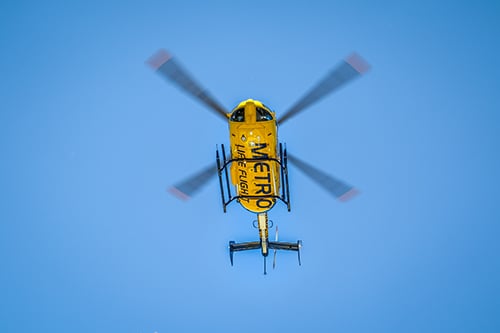Aircraft Safety
To ensure safe operations of the helicopter in and around helipads and other designated landing areas, Metro Life Flight utilizes the safety precautions below. These are the minimum required; additional safety procedures should be implemented, as required by participating hospitals.
- Hospital safety authorities must make frequent regular inspections of the helipad or landing area to ensure that all loose items which may be blown by the helicopter rotor wash are moved out to a safe distance or are secured in place. Particular attention must be given to construction areas. All items must be considered. Papers can cause engine failures if ingested, plastic bags and the like can cause control failures. Unsecured items can be blown and cause injury.
- Establish a safety perimeter to keep personnel at a safe distance; 200 feet is usually sufficient for persons in the open. If closer, individuals should be behind a sturdy barrier.
- A fire extinguisher should be located at the landing pad and ready for use if required. Local ordinance may require a fire truck to be on location as well. If so, it should be kept 100 feet from the touchdown area. Usually, once the helicopter is shut down there is no further need of the fire department, unless local ordinances require it.
- If the hospital security or local law enforcement personnel are present, they should be dispersed to keep unauthorized individuals at a safe distance.
- No one is allowed on the helipad during take-off and landing.
- Do not approach the helicopter, unless signaled to do so by the pilot. One of the pilots will disembark from the helicopter after landing. Follow his instructions and signals. Unless you are asked to help, please stay outside the safety perimeter.
- Normally the rotor blades will be stopped before anyone is allowed to approach or depart from the helicopter. In certain cases, such as patient urgency or weather conditions, it may be appropriate to load or unload the patient while the blades are turning. If it is necessary to approach the helicopter, proceed as follows:
- Only approach the helicopter when instructed by a pilot.
- Stay away from the rear of the helicopter. If it is necessary to go to the other side of the helicopter, go around the front of the aircraft, not the rear.
- Be careful of the airspeed probes (pitot tubes) on the front of the helicopter. They are sharp and may be very hot and can cause severe burns.
- Keep your head down when passing under the blades.
- Approach and depart the helicopter from the side (90 degree angle from the front). This will give the pilot the best view of your movements.
- Long objects should be held horizontally. I.V. bags should be held as low as possible and nothing should be held above your head height.
- A Metro Life Flight pilot will direct the loading and unloading of the patient. A pilot will open and close the doors of the helicopter.
- No running within 50 feet of the helicopter.
- There should be no loose articles within the safety perimeter of the helicopter.
- No vehicle should be driven closer than 50 feet of the helicopter. Do not back up toward the helicopter. Do not drive behind the helicopter in the vicinity of the tail rotor.
- Only authorized personnel will be allowed on the landing area. The pilot will have the final authority as to who is allowed to approach the helicopter.

All FAA Part 135 aviation services for Metro Life Flight are provided by Metro Aviation, Inc. which maintains exclusive operational control over all aircraft.
